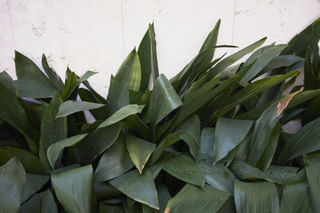The ultimate guide to taking care of a Cast Iron Plant (Aspidistra elatior)

Taking care of a Cast Iron Plant is easy! Make sure it gets enough light and humidity, give it regular water, and mist it every now and then. That way, your plant can live for up to 50 years and be healthy and strong!
To give you the best chance to take care of this plant, I've broken down the caring process into a few different steps. These steps give you the most in-depth information to teach you everything you need to know about caring for your plant.
-
How to take care of a Cast Iron Plant (Aspidistra elatior)
1
. How to take care of a Cast Iron Plant (Aspidistra elatior)
Back to the top
In this plant care guide, you'll find everything you need to know to take care of the Cast Iron Plant (Aspidistra elatior). Learn how to water, fertilize, propagate and repot your plant. Keep it healthy with tips on dealing with pests and other issues you might find.
Read "How to take care of a Cast Iron Plant (Aspidistra elatior)"
Signs an Aspidistra is unhealthy and needs attention
Spotting signs of an unhealthy Aspidistra early on can help you tackle issues quickly and get your plant back to good health. Here are some common signs that your plant might need some care and possible reasons why:
Yellowing leaves
- Overwatering: One of the main reasons for yellow leaves is overwatering, which can cause root rot.
- Underwatering: On the flip side, not watering enough can also make the leaves turn yellow.
- Nutrient deficiency: Not getting enough essential nutrients, especially nitrogen, can lead to yellowing leaves.
Brown tips or edges
- Low humidity: Dry air can cause leaf tips and edges to turn brown.
- Chemical sensitivity: Tap water with chlorine or fluoride can brown leaves. Try using filtered or distilled water.
- Over-fertilization: Too much fertilizer can burn leaf edges, making them brown.
Wilting or drooping leaves
- Underwatering: Not giving enough water can make the leaves wilt or droop.
- Root issues: Problems like root rot can stop the plant from absorbing water properly, causing it to wilt.
Leaf spots or patches
- Fungal infections: Brown or black spots on the leaves might mean fungal issues like leaf spot or anthracnose.
- Pest infestation: Tiny spots or patches could be due to pests like spider mites or scale insects.
Stunted growth
- Nutrient deficiency: Not getting enough essential nutrients can slow down or stunt growth.
- Poor light conditions: Not enough light can hold back the plant's growth.
Mold or fungi on soil
- Overwatering: Keeping the soil too wet can lead to mold or fungi growth.
Pale or faded leaves
- Not enough light: Without enough light, leaves can turn pale or faded.
- Nutrient shortage: A lack of iron or other vital nutrients can cause chlorosis, making leaves look pale.
Scientific classification of Aspidistra elatior
Plants go by many names, but it can become confusing very quickly if you're talking about different plants with the same nickname. That's why I'm including the scientific name of the plant, so we're all on the same page!
|
Classification
|
Name
|
|
Species
|
Aspidistra elatior |
Frequently asked questions
How should you water the Cast Iron Plant (Aspidistra elatior)?
The Cast Iron Plant (Aspidistra elatior) likes to be watered occasionally, but also needs to soil to dry out slightly. Water when the top of the soil has dried out.
How much sunlight does the Cast Iron Plant (Aspidistra elatior) need?
The Cast Iron Plant (Aspidistra elatior) prefers a darker spot of your house: a spot where it gets low-light sunlight exposure. Your Cast Iron Plant (Aspidistra elatior) doesn't like too much light.
How much fertilizer does the Cast Iron Plant (Aspidistra elatior) need?
The Cast Iron Plant (Aspidistra elatior) needs quite a bit of energy to grow, so you should fertilize it once per month in the spring and summer.
What is the best soil for the Cast Iron Plant (Aspidistra elatior)?
The Cast Iron Plant (Aspidistra elatior) likes to be watered when the top of the soil is dry, so use a soil mix that drains excess moisture quickly and holds onto some moisture for a few days.
What is the ideal temperature for the Cast Iron Plant (Aspidistra elatior)?
The Cast Iron Plant (Aspidistra elatior) prefers a spot that consistently stays between 15 - 29°C (59 - 84°F).
How do you propagate the Cast Iron Plant (Aspidistra elatior)?
To propagate the Cast Iron Plant (Aspidistra elatior), you'll have to divide the Cast Iron Plant (Aspidistra elatior) and grow each part separately. This is quite damaging, so don't do this too often.
How often should you repot the Cast Iron Plant (Aspidistra elatior)?
You should repot your Cast Iron Plant (Aspidistra elatior) once every 2 year(s). This helps your Cast Iron Plant (Aspidistra elatior) to stay healthy for many years.
Is the Cast Iron Plant (Aspidistra elatior) easy to take care of?
The Cast Iron Plant (Aspidistra elatior) is easy to take care of and great for beginners.
Didn't find what you were looking for?
We have resources about other plants and plant-related topics as well.
Perhaps these resources contain the information you're looking for.
I've written a lot of guides about all kinds of aspects of taking care of plants, but I could've missed that specific topic you were looking for. If that's the case, you can request a plant guide. This way I can provide you with the information you need quickly and you won't have to wonder if you're taking care of your plant properly anymore.


